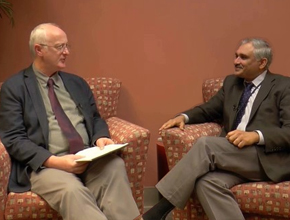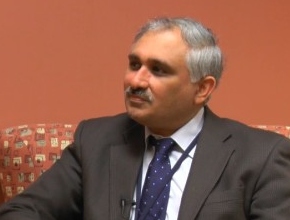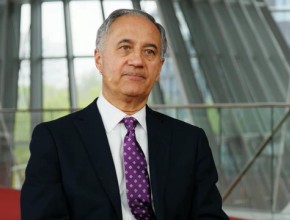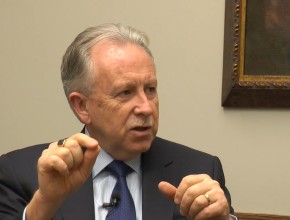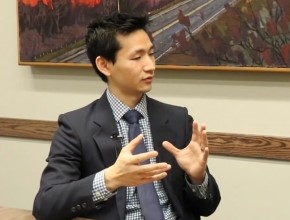Related McMaster Perspective episodes
Nair P, Jaeschke R. The future of medicine is here. Part 1: Benralizumab in asthma.References
Nair P, Wenzel S, Rabe KF, et al; ZONDA Trial Investigators. Oral Glucocorticoid-Sparing Effect of Benralizumab in Severe Asthma. N Engl J Med. 2017 Jun 22;376(25):2448-2458. doi: 10.1056/NEJMoa1703501. Epub 2017 May 22. PubMed PMID: 28530840.Roman Jaeschke: We will maybe talk a little bit more about the clinical applications of those drugs, but let me switch focus for a second. This particular drug you are talking to us about is anti-interleukin (IL) 5.
Parameswaran Nair: Yes.
Roman Jaeschke: In general, what are the mechanisms of action of biologics in asthma?
Parameswaran Nair: There are only 4 biologics that have been approved. Omalizumab is a monoclonal antibody against IgE. Mepolizumab, or Nucala, is an IgG1 monoclonal antibody against IL-5. There is a second monoclonal antibody against IL-5 that is called reslizumab, or Cinqair. And this molecule that we just talked about is benralizumab, or Fasenra, and that is directed against the IL-5 receptor. So we have got one against IgE and three against IL-5, two of which are against a cytokine and one against a receptor for the cytokine.
Roman Jaeschke: They obviously take part in the pathophysiology of airway constriction. I hear something about IL-12 or IL-13.
Parameswaran Nair: Right. IL-12 does not have a direct role in asthma pathobiology, but IL-13 is another TH2 cytokine, which plays a very important role in asthma biology, particularly in goblet cell hyperplasia, mucus hypersecretion, airway hyperresponsiveness, and the recruitment of inflammatory cells into the airway.
There was a lot of interest in developing and evaluating monoclonal antibodies directed against IL-13. Two such molecules were developed. One was lebrikizumab and the second one was tralokinumab. Both of them went through phase 2 clinical trials. They were very effective. However, in the phase 3 clinical trials with exacerbations as a primary outcome, compared to placebo the response did not meet the prespecified statistical significance. It could be due to a number of reasons. I think it is not because IL-13 is not relevant in asthma biology, but the studies were just not done properly. The patient selection and characterization were suboptimal and there were problems with study design. However, since the studies were negative, the companies that manufacture the drugs have decided not to go forward and we will not have those drugs available to us to treat patients.
Roman Jaeschke: Anything else in biological pipeline? We talk about IL-5, IL-13.
Parameswaran Nair: There is another drug which targets the IL-13 pathway that is called dupilumab. This molecule is interesting. It is a monoclonal antibody directed against the receptor for IL-4. This receptor is also utilized by IL-13. In effect this molecule would be blocking both IL-4 and IL-13. This molecule has just been approved for the treatment of atopic dermatitis, and because IL-4 and IL-13 are very effective in the whole allergy diathesis it might be effective in patients with sinus disease, asthma, eosinophilic esophagitis, and eczema and atopic dermatitis. Phase 3 clinical trials are currently underway. We should have the results and hopefully a publication very soon. Phase 2 clinical trials were very effective. So we may have a drug that blocks IL-4 and IL-13 approved sometime this year.
Roman Jaeschke: All those drugs which you mention—I am starting to get the feel for the field—are influencing eosinophils one way or the other. Are there any biologics used for airway constrictions not related to eosinophils?
Parameswaran Nair: The drug that I mentioned just a little while ago, dupilumab, that targets the IL-4 and IL-13 pathway has been shown to have an effect independent of eosinophil. It is not an antieosinophil drug. It is an anti–TH2 cytokine drug. In the clinical trials that have been done so far, the drug was effective even in patients who do not have a predominant eosinophilic component; however, they should have a TH2 disease and there should be some evidence of a TH2 immunology for these anti-TH2 drugs to work.
Roman Jaeschke: My apologies. TH2?
Parameswaran Nair: The TH2-type lymphocyte, as opposed to the TH1-type lymphocyte, that would produce the cytokines known to be associated with allergic asthma; these would be IL-4, IL-5, IL-9, IL-13, etc.
Roman Jaeschke: That is the future for the next 5 years. We have a lot to learn and remember.
Parameswaran Nair: We have not finished yet. There is another monoclonal antibody that is just entering the phase 3 clinical trial. All these cytokines that we have talked about come from lymphocytes, TH2 lymphocytes. There is a class of proteins that are produced from the epithelium. In patients who have no allergies, after what the patients would describe as an innocuous upper respiratory tract infection, the epithelium could get damaged and the epithelium produces proteins called alarmins. One of them is thymic stromal lymphopoietin (TSLP), and another alarmin is IL-33, interleukin 33. These two cytokines are considered to be critical in causing asthma pathophysiology by acting on these TH2 lymphocytes. A clinical trial from McMaster University led by Paul O’Byrne had shown in an allergen challenge model that blocking TSLP is also very effective in attenuating the physiology associated with asthma. These molecules are also now in clinical trials, so we may have yet another monoclonal antibody available to us if the phase 3 trials are successful.
So from famine we are going to flood. We are going to have about 5 or 6 monoclonal antibodies available to us to treat patients with asthma.
Roman Jaeschke: Flood for sure. Where is the clinical role of those drugs as of today? Where do you see them being employed?
Parameswaran Nair: I think these drugs are to be used only in the very severe patients. In patients who can be well controlled on inhaled corticosteroids and long-acting bronchodilators, I do not currently see a role for these drugs for two reasons. Firstly, these act on specific cytokines, or specific cells. Corticosteroids have a more widespread action; they act on many aspects of asthma pathobiology, and we know that these corticosteroids have disease-modifying effects. We do not yet have evidence that blocking one cell or one cytokine over a long term would have disease-modifying effects, and until that evidence is available, it is not prudent to substitute or initiate treatment at an early stage in the course of asthma with these biologics.
Secondly, cost would be an important factor. These drugs at the moment are very expensive and therefore any health-care system would not be able to sustain the use of these biologics for a common disease, such as asthma, at the prevalence of about 10%.
 English
English
 Español
Español
 українська
українська

